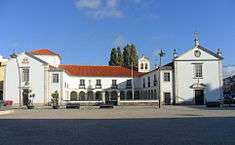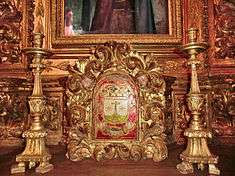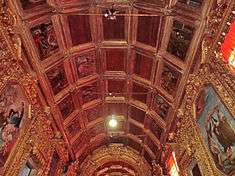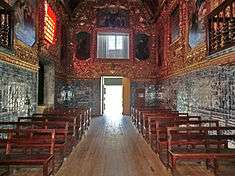Church of São João Evangelista (Aveiro)
| Church of São João Evangelista (Igreja de São João Evangelista) | |
| Church of Discalced Carmelites, Church of St. John the Evangelist | |
| Church (Igreja) | |
 The Church of São Evangelista (right) and the former annexes of the Carmelite Convent | |
| Official name: Igreja das Carmelitas/Igreja de São João Evangelista | |
| Named for: John the Evangelist | |
| Country | |
|---|---|
| Region | Centro |
| Subregion | Baixo Vouga |
| District | Aveiro |
| Municipality | Aveiro |
| Location | Glória e Vera Cruz |
| Styles | Baroque, Roccoco |
| Materials | Masonry, Limestone, Azulejo, Wood, Tile |
| Owner | Portuguese Republic |
| For public | Public |
| Easiest access | Praça Marquês de Pombal, Rua de Joaquim António de Aguiar (former Rua das Carmelitas) |
| Management | Instituto Gestão do Patrimonio Arquitectónico e Arqueológico |
| Status | National Monument Monumento Nacional |
| Listing | Decree 16 June 1910; Diário do Governo 136, 23 June 1910; Special Protection Zone (ZEP), Diário do Governo Dispatch, Série 2, 11, 13 January 1961 |
| Wikimedia Commons: Igreja das Carmelitas | |
A Church of São João Evangelista (Portuguese: Igreja de São João Evangelista), or Carmelite Church of Aveiro, is an 18th-century church, located in the Praça Marquês de Pombal, in the civil parish of Glória e Vera Cruz, in the Portuguese municipality of Aveiro, classified as a national monument since 1910.
History


A refuge for Discalced Carmelites, the monastery of São João Evangelista was constructed in 1657, following the request of Aveirense patron D. Brites de Lara (widow of Pedro de Médicis, son of Cosimo de' Medici) in her last will and testament.[1][2] Originally constructed as a residential palace, a petition was made to King D. John IV to establish this convent.[2] Authorization was conceded posthumously, and only after his descendent (Raimundo of Lencastre, 4th Duke of Aveiro) began the work of adapting the former-residence to a convent.[1][2][3] The first Carmelite sisters began arriving from convents in Lisbon in 1658.[1][4]
The first phase of the convent's construction continued through the reign of King D. Peter II. The church was begun in 1704, and involved the transformation of the chapel into a formal temple.[2][5] In succeeding years there were various campaigns to expand and improve the structure along the 18th century, resulting in profound renovations and decoration of the spaces (the included gilded woodwork, azulejo tile, paintings and sculpture). The last work was completed in 1738 by D. Gabriel, 7th Duke of Aveiro.[1]
The last Carmelite at the convent died on 1879.[1]
In 1905, the convent was almost completely destroyed in order to expand the main square.[1][2][6]
On 1 June 1992 the property came under care of the Instituto Português do Património Arquitetónico (Portuguese Institute of Architectural Patrimony), under Decree-law 106F/92 (Diário da Repúblic, Série A, 126).[1] On 14 August, a public competition was held to complete conservation and restoration work on the property.[1]
Architecture


The church is located in an urban area, addorsed to the remains of the former-annexes of the old convent, currently occupied by offices of the Public Security Police (PSP) force and fronting the public square, that includes landscaped modern administrative buildings.[1] In addition, the structure fronts the judicial courts, the Civil Governor's building (on its left) and the postal offices (on its right, while the former fire station is located to its left.[1]
Presenting a somber facade, the simple rectangular church, with a sacristy located along the axis of the presbytery.[2] The interior is decorated in ornate gilded woodwork, that cover the walls and ceilings in proto-Baroque, Baroque and Rococo architectural styles.[2] In addition to framing a number of wall paintings, similar woodwork frames an image of the life of Mary (in the presbytery), the life of Christ (on the ceiling) and the life of Saint Teresa of Ávila (along the nave). Halfway up the walls are blue and white azulejo tile, attributed to 18th century artisan António Vital Rifarto of Coimbra, who was also responsible for gilded woodwork to the ceiling.[2][7]
References
Notes
- 1 2 3 4 5 6 7 8 9 10 Alçada, Margarida; Ruão, Carlos; Costa, Anouk (1998), SIPA, ed., Igreja das Carmelitas/Igreja de São João Evangelista (IPA.00001041/PT020105060002) (in Portuguese), Lisbon, Portugal: SIPA – Sistema de Informação para o Património Arquitectónico, archived from the original on 7 March 2016, retrieved 17 September 2015
- 1 2 3 4 5 6 7 8 Carvalho, Rosário (2015), DGPC, ed., Igreja das Carmelitas (in Portuguese), Lisbon, Portugal: Direção-Geral do Património Cultural, retrieved 19 September 2014
- ↑ José Martins Belinquete (1996), p.6
- ↑ José Martins Belinquete (1996), p.16-17
- ↑ Francisco Ferreira Neves (1957), p. 244
- ↑ Francisco Ferreira Neves (1957), p. 245
- ↑ José António Ferreira de Almeida (19769, p.112-113
Sources
- Neves, Francisco Ferreira (1957), A fundação e extinção do convento das carmelitas descalças de Aveiro (in Portuguese) (XXIII ed.), Arquivo do Distrito de Aveiro, pp. 241–257
- Gonçalves, Nogueira (1959), Inventário Artístico de Portugal (in Portuguese) (VI ed.), Lisbon: Distrito de Aveiro, pp. 130–133
- Ministério das Obras Públicas, ed. (1960), Relatório da Actividade do Ministério nos Anos de 1959 (in Portuguese), I, Lisbon
- Neves, Amaro (1984), Aveiro. História e Arte (in Portuguese), Aveiro, Portugal
- Gil, Júlio; Calvert, Nuno (1995), As mais belas cidades de Portugal, Lisbon, Portugal, p. 90
- Almeida, José António Ferreira de (1976), "Tesouros Artísticos de Portugal", Seleções do Reader's Digest (in Portuguese), Lisbon, pp. 112–113
- Belinquete, José Martins (1996), As carmelitas em Aveiro ontem e hoje (in Portuguese), Aveiro, Portugal